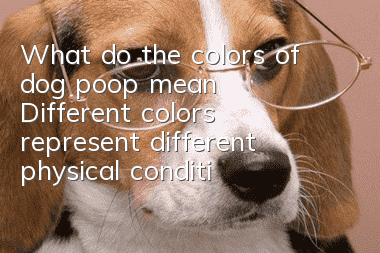What do the colors of dog poop mean? Different colors represent different physical conditions of dogs.

Dog poop is tan and yellow
For normal and healthy dogs, the color of poop is usually brown or brown. This is the color excreted by pet dogs after normal digestion. If the color of your dog's stool is yellowish or very yellow, it may be that the food your dog eats contains high carbohydrates, such as beans, corn, rice, wheat, steamed bread, etc.Dog poop is white or gray
The most common reason for this is that the dog eats too many bones. Stool of this color is usually divided into small sections and is dry and crumbly. Owners should pay attention to reducing the amount of bones they feed, otherwise they may easily cause constipation in dogs. If you don’t feed bones, it may also be caused by stones or roundworms in the biliary tract, which prevents biliflavin from being excreted smoothly with the stool, so the dog’s stool is colorless.Dog poop is orange or orange
This color of poop is an unhealthy color. The stool is thick, shapeless and contains orange residue. This kind of stool usually occurs in dogs with loose diarrhea or poor digestion. Owners should not feed their dogs food that is not easy to digest on a daily basis, as this can easily lead to indigestion and diarrhea.Dogs poop green
Dogs poop green may be because the owner feeds the dog too much vegetables and fruits containing high chlorophyll such as cucumber, lettuce, lettuce or celery. It’s caused by the dog’s inability to absorb all of it. It is also possible that the dog ate some grass or something containing dyes and pigments. It may also be caused by excessive acidity in the dog’s intestines.Dog’s stool is red with blood
If your dog’s stool has bloody mucus or blood streaks, these are extremely abnormal symptoms. You can first check whether it is caused by an anal fissure. If not, it may be that the dog has coccidia or lower gastrointestinal bleeding, causing blood in the stool. The gastrointestinal function of puppies under 3 months old is relatively fragile. Feeding dry and hard dog food, swallowing bones and foreign objects can easily cause intestinal scratches. If your dog is lethargic and has a fever, it is most likely caused by acute gastroenteritis. If your dog has blood in his stool frequently or non-stop, he may have a parasite problem.Dog poop is black
There are two situations when a dog poops black. The first is normal and healthy. For example, if the dog eats dog food that contains high amounts of meat, then the poop will be black. The color of the stool will be darker. Another situation is that the dog’s duodenum, small intestine and other digestive organs bleed, causing the dog to have black and dark stools, and some stools are accompanied by intestinal mucosa. Random articles
- What do dogs eat to protect their stomach? It is important to protect their stomach and treat gastrointestinal diseases in dogs.
- How to tell if your dog is fat? Is your dog overweight?
- Will your dog catch a cold if you blow the air conditioner? What should you do if your dog catches a cold if you blow the air conditioner?
- What should you pay attention to when your dog drinks water? Don’t be careless when it comes to your dog’s drinking water.
- The dog's mouth bites and shakes. Why does the dog's mouth occasionally shake and bite?
- How to cut a dog's hair? Do you know how to cut a dog's hair correctly?
- Can dogs eat raw eggs? Why can’t dogs eat egg whites?
- Common Dog Problems in Summer How to Deal with Different Dog Problems
- How to keep dogs away from skin diseases. If you do this, will you see if your dog will still be infected with skin diseases?
- What causes anorexia in dogs? Dogs will become anorexic due to lack of exercise. Hounds run at least 5KM every day.



